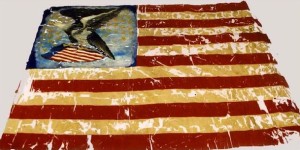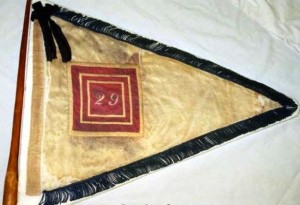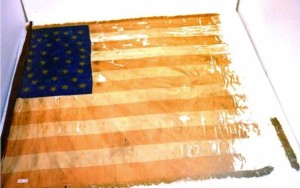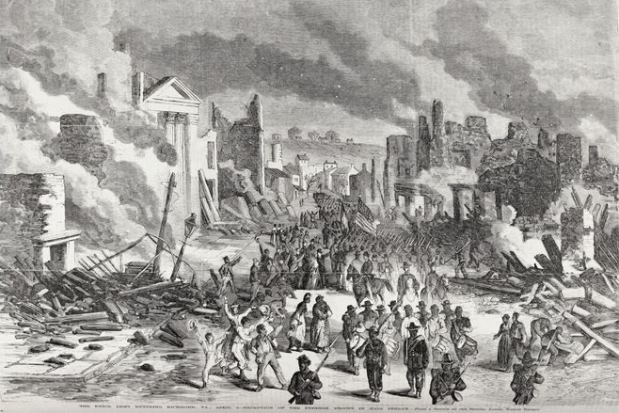By Cornel Garfman
Civil War Battle Flags
During the American Civil War, battle flags were so important to soldiers, men would routinely risk their lives so that their unit banner would not be captured by the enemy. Because they represented a unit’s home state, soldiers took great pride in regimental battle flags and treated them with great reverence. Flags, which were carried by a designated team known as the color guard, also marked the position of the regiment on the battlefield. A typical regimental color guard would consist of two color bearers, one carrying a US or Confederate flag, often referred to as a unit’s “national” colors, and one carrying the state, or “regimental,” flag. Considered a great honor, being in a color guard required a soldier to be extraordinarily brave, as the enemy often aimed their guns at an opposing army’s regimental flags. Consequently, the mortality rate of color bearers was quite high and there are countless stories of them being wounded or killed. After the war, most state governments put a great deal of effort into collecting and maintaining their battle flags, and although they were looked upon with great veneration well into the 20th century, these collections have been largely forgotten in modern times. Yet, state battle flag collections still exist, and with 110 flags, Connecticut owns one of the grandest assortments of military banners in the nation. Among them is a particularly unique flag display dedicated to the state’s first black military unit.
The Battle Flags of the 29th Connecticut Volunteer Infantry
Of the nearly 200,000 black soldiers who fought for the Union in the Civil War, most were assigned to a portion of the US Army created to oversee all African American regiments, known as the United States Colored Troops (USCT). Four black regiments (three in Massachusetts, including the famed 54th immortalized in the film Glory, and Connecticut’s 29th (Colored) Volunteer Infantry (CVI)) retained their original state designations throughout the war.

This 29th (Colored) Regiment CVI 33-star US “National” flag was presented to the unit March 8, 1864, in Fair Haven, CT – Courtesy of the Connecticut Office of Legislative Management, from the book Qui Transtulit Sustinet by Geraldine Caughman
Comprised of ten companies totaling approximately 1,000 men, the 29th CVI was presented with its first battle flag, a 33-star US banner, by a local minister, the Reverend Dr. Mott, on March 8, 1864, in the Fair Haven section of New Haven, Connecticut. The men made no show of emotion during the formal ceremony, recalled Isaac J. Hill in his book, A Sketch of the 29th Regiment of the Connecticut Colored Troops, “on account of the Regiment not receiving the $75 which was promised to them at their enlistment.” A little over a week later, on March 19, the New Haven Daily Palladium reported that a local black woman presented to the unit its second battle flag—its regimental colors. As the dark blue silk flag was handed over to the unit’s new commander, Colonel William B. Wooster of Derby, the father of one of the unit’s officers, the Reverend Dr. Leonard Bacon, gave a long and passionate speech in which he told the soldiers, “We give you this flag to march under which tells you that you are a Connecticut regiment, and it is our confident expectation that you as a regiment will do honor to the State of Connecticut, as well as to the stars and stripes. And in order to do this, you must bring back this flag when you return, without any dishonor.” Bacon concluded by reminding the 1,005 soldiers that as men of color, they would need to prove “worthy of the respect of fellow men,” in particular, whites. Immediately following the ceremony, as the regiment marched towards the wharf where the steamship Warrior was waiting to take them to the front, the soldiers could be heard shouting, “We’ll show you we can fight! We’ll show you that we are men!”

One of the two 29th (Colored) Regiment CVI guidon flags used as markers on the left and right flank of the regiment during battle. It is unknown when the unit received these flags – Courtesy of the Connecticut Office of Legislative Management, from the book Qui Transtulit Sustinet by Geraldine Caughman
Throughout the war, in addition to the two flags presented in March of 1864, the regiment also carried two small, white triangular flags, each displaying the unit’s number. These flags, known as guidons, were carried into battle on hand-carved wooden staffs on the left and right flanks of the regiment. It is unknown how or when the unit came into possession of these two flags, but when they were discovered in the mid-1980s, a small piece of black mourning cloth was found tied to one of the banners and is believed to have been placed there either in honor of men of the 29th killed in action or for President Abraham Lincoln.

The 29th (Colored) Regiment CVI 35-star US “National” flag was presented to the unit when it became part of the 25th Army Corps in March of 1865 – Courtesy of the Connecticut Office of Legislative Management, from the book Qui Transtulit Sustinet by Geraldine Caughman
In March of 1865, just a few weeks before the end of the war, the regiment became part of the 25th Army Corps and received a second US flag, this time with 35 stars. At the ceremony, Colonel Ulysses Doubleday, 2nd Brigade Commander, praised the bravery of the 29th in his presentation speech, and according to unit historian Reverend Henry G. Marshall in History of the Twenty-ninth (Colored) Regiment Connecticut Volunteer Infantry; In Record of Service of Connecticut Men in the Army and Navy of the United States During the War of the Rebellion, companies C and G of the 29th became the first union infantry soldiers to enter the Confederate capital of Richmond, Virginia, when it fell on April 3, 1865. Later that same day, according to A. H. Newton in his book, Out of the Briars – An Autobiography and Sketch of the Twenty-Ninth Regiment Connecticut Volunteers, President Abraham Lincoln himself must have laid eyes on the 29th’s battle flags as he made a “triumphant entry into the city” to survey the scene, a mere twelve days before the commander in chief was killed by an assassin’s bullet.

“The Union Army Entering Richmond, VA., April 3,” from Frank Leslie’s Illustrated Newspaper, April 25, 1865
According to unit biographer Diana Ross McCain, during its course of service, the 29th suffered nearly 500 casualties in a half-dozen battles in Virginia. After the Confederacy surrendered, the unit was shipped to Texas for several months to perform guard duty. Upon returning to Connecticut, the soldiers of the 29th were given a hearty welcome by Hartford Mayor Allyn S. Stillman, Connecticut Governor William A. Buckingham, and the state’s most celebrated Civil War soldier, General Joseph Roswell Hawley. The Hartford Courant reported that on November 25, 1865, the day the unit was discharged, Hawley applauded the soldiers (who were described as “slouching and weary-looking”) in particular, for their performance the year before while he served as their commander at the Battle of Darbytown Road, Virginia. Hawley closed his speech by saying that the men of the regiment deserved all rights and privileges afforded citizens of the country (although full citizenship for black Americans would not be realized for another three years with the passage of the Fourteenth Amendment).
The Flags through the Years
Along with Connecticut’s other regiments, the 29th turned over its colors to the state when the war ended, and for the next 14 years, the entire collection sat in the old State Arsenal on North Main Street in Hartford. On September 17, 1879, however, the 17th anniversary of the Battle of Antietam, Connecticut’s 110 Civil War flags were moved during a massive celebration (known as Battle Flag Day) honoring the state’s veterans.
By most accounts, at least 100,000 spectators turned out for the event which began when approximately 10,000 veterans formed by regiment at the arsenal to collect their faded and tattered battle flags. The men then marched to the sound of band music, ringing bells, and thousands of cheering spectators along the entire length of Hartford’s Main Street to the new state capitol building. A Hartford Courant article covering the day’s events reported that it took an hour and a half for the three-mile-long procession of assembled veterans to move past the armory with their battle flags.
Among the veterans, about 200 soldiers from the combined 29th and 30th black regiments participated in the festivities. An additional 38-star US flag, representing both regiments, is believed to have been made especially for the event.

The combined 29th and 30th (Colored) Regiments CVI 38-star US “National” flag is believed to have been created especially for Battle Flag Day, September 17, 1879 – Courtesy of the Connecticut Office of Legislative Management, from the book Qui Transtulit Sustinet by Geraldine Caughman
According to the History of Battle-Flag Day, Sept. 17, 1879, four veterans of the two units, namely, Alfred Somers, Richard Simmons, Bland Merdy, and William Gidy, were chosen to be the Battle Flag Day color bearers. As such, they collectively carried the 29th’s regimental flag (which was described at the time as “badly gone”) as well as the unit’s two US battle flags, regarded as in “fair shape.” The US flag of the 30th regiment was also carried along the procession route to the capitol building. Following speeches by General Hawley and Connecticut Governor Charles B. Andrews, the four men took their place at the end of a long line of other color bearers and entered the west vestibule of the capitol. The men then placed the state’s last four battle streamers into their designated spots inside the newly constructed cases in the Hall of Flags.
As time faded memories of the war, reports on the flags were rare. In fact, over the next century, there were only three known mentions in the press of either the 29th or 30th battle flags. The first occurred in May 1904, on the 25th anniversary of Battle Flag Day, when, according to the Hartford Courant, about 7,000 Connecticut Civil War veterans again paraded through the streets of Hartford. Although not as grand a celebration as the one a quarter of a century before, crowds of spectators nevertheless honored the now aged veterans with much back slapping and hearty cheering. The day’s celebrations ended with the procession passing through the capitol’s Hall of Flags to view the regimental battle flags. For many of the old soldiers, then in their twilight years, it would be the last time they ever saw the flags.
Not until 1938, when a brief Hartford Courant article reported on how the combined 29th and 30th US battle flag was to be placed in the Hall of Flags, was there any other mention of the flags. And for the next 50 years only one other notable event having anything to do with the flags was reported in the Hartford Courant, when in February of 1945, Fred Seymour, son of a 29th veteran, spoke of the bravery of the regiments as plaques were attached to each unit’s regimental battle flag standard in the Hall of Flags.
Conserving the Colors of the 29th Connecticut Volunteer Infantry
Few people have had more to do with the state’s battle flags in the last 100 years than the late Geraldine Caughman, who literally wrote the book on the subject. Published in 1997, her two-volume book, Qui Transtulit Sustinet, takes its name from the Connecticut state motto, translated, “He who transplanted sustains,” a phrase emblazoned across many of the state’s Civil War battle streamers, including that of the 29th regimental flag. Qui Transtulit Sustinet is the most complete study ever done on Connecticut’s 110-flag collection. After working for many years as a tour guide with the state’s League of Women Voters, in 1985, Caughman was effectively appointed caretaker of the flags when the Hall of Flags was emptied as part of a massive $51 million restoration of the capitol building. By then badly deteriorated, the 29th regimental banner was carefully furled in sheets of acid-free paper, wrapped in muslin, and placed in a small storage room at the capitol along with dozens of other flags from the state’s collection.
By the mid-1990s, little more than half of the original 29th regimental battle flag, which had been 50 inches wide and 72 inches tall, remained. What was left of the flag’s hand-embroidered blue silk material was faded, burned, or torn in several spots, and portions of the metallic bullion tassel fringe on the top and bottom of the banner were missing or had become separated. Additionally, the 119 inch hardwood, hinged staff had lost its finial.
In 1996, an impetus to conserve the flag was provided when the Connecticut Historical Society, in partnership with the Secretary of State’s office, launched a summer-long exhibit at the Charter Oak Cultural Center titled, A Struggle from the Start: The Black Community of Hartford, 1639 – 1960. As part of the exhibit, one of the 29th’s CVI guidons was removed from its display at the Hall of Flags and included in the exhibit. Taking the idea to the physical facilities subcommittee of legislative management, the late Monsignor Joseph A. Devine, chairman of the Connecticut State Capitol Preservation and Restoration Commission, established conditions for state participation in a project to redisplay the flag that included specifications for fund-raising and related matters and a stipulation that the regimental banner not be mounted flat.
In 2002, after the commission appropriated money to cover the cost, they commissioned Jessica Hack Restoration in New Orleans, Louisiana, to conserve the 29th regimental battle flag. In the official treatment report on file with the state, the entire project of cleaning, re-stitching, and stabilizing the flag took over 300 hours and cost nearly $10,000. Because of extensive damage, however, officials at the capitol ultimately decided to mount the battle streamer flat. A request was also made to move the Ball, Black & Co. manufacturer’s label from the back of the flag to the front to make it visible to the public. Shortly after it was returned to Connecticut, the regimental steamer became the centerpiece of a collection of other flat-mounted flags in a glass room in the basement of the capitol.
Currently, the 29th CVI’s two US flags, as well as the combined 29th and 30th flag which was specially designed for Battle Flag Day, are far too deteriorated to display. Although, according to Connecticut General Assembly Facilities Engineer Eric Connery, the state plans to eventually conserve these flags, only the hinged, wooden staff of the 29th regimental battle flag remains in the Hall of Flags. As for the flag itself, it has not moved from its display in the basement of the capitol since it was first placed there over a decade ago. It is joined to its left and right by both unit guidons along with the wooden staffs that carried them in battle. Three small flags of the 1st Regiment of the Connecticut Volunteer Heavy Artillery and the regimental flag of the 1st Connecticut Calvary, which was conserved in 1987, are also part of the display. The exhibit is rounded out by other small artifacts which complement the 29th’s story, such as a picture and short biography of Sgt. William Harvey Carney of the 54th Massachusetts Infantry who became the first African American to be awarded the Medal of Honor, after saving one of the unit’s regimental flags from capture despite being severely wounded at the Battle of Fort Wagner.
Cornel Garfman, MS, is a writer and historian.
This article was published as part of a semester-long graduate student project at Central Connecticut State University that examined Civil War monuments and their histories in and around the State Capitol in Hartford, Connecticut.
<< Previous – Home – Next >>









